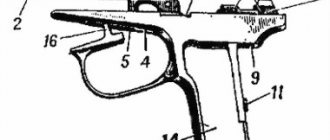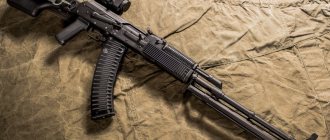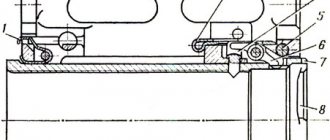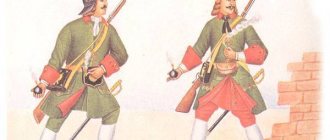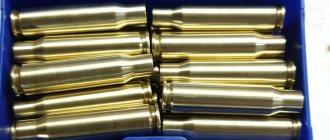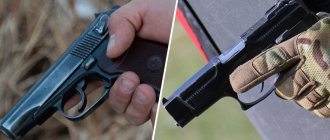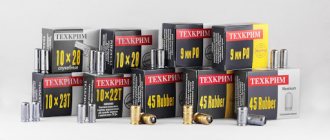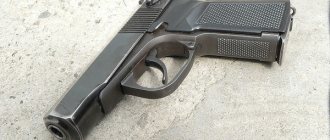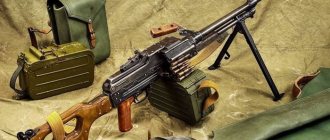Each hunter himself selects for himself the numbers of fractions convenient for hunting a particular animal or bird. Some people shoot at a goose with shot number 1, since it hits the head, while others use shot number 00, since it is more difficult to penetrate the dense feathers on the chest with one.
When choosing a shot, you also need to take into account the seasonality of hunting. In winter, the animal's plumage or fur is denser, making it difficult to penetrate. The usual distance to the target is approximately 35-40 meters.
| Fraction number | Diameter, mm | On whom |
| 12 (small) | 1,25 | Quail, snipe, snipe and other small birds |
| 11 (small) | 1,50 | |
| 10 (small) | 1,75 | |
| 9 (small) | 2 | |
| 8 (small) | 2,25 | |
| 7 (small) | 2,50 | Ducks, pheasants and other larger birds, teals |
| 6 (small) | 2,75 | |
| 5 (small) | 3 | |
| 4 (average) | 3,25 | Can be used on goose, hare, black grouse |
| 3 (average) | 3,50 | |
| 2 (average) | 3,75 | |
| 1(medium) | 4 | Hare, goose, fox, wood grouse. |
| 0 (large) | 4,25 | |
| 00 (large) | 4,50 | Larger animals such as roe deer, lynx, etc. Can be used on hare, goose |
| 000 (large) | 4,75 | |
| 0000 (large) | 5 |
The table shows the numbers of fractions, their diameter and who they are used for. The fraction pitch is 0.25 mm. As can already be seen, the higher the number of the fraction, the finer it is.
Buckshot
The shot is above 5mm. Necessary for hunting large animals, such as roe deer. It is recommended that the buckshot be kept in a container. There is a concept of matched buckshot. This is when buckshot is placed in layers in a cartridge and the shot follows each other. To achieve this, use cups for laying in rows. But manufacturers don’t bother too much about this issue and arrange it as they please.
What is a cartridge, what functions does it perform?
An electrical system consists of many elements. These are lamps, connection cables and special installations that are necessary to control or communicate different parts. Cartridges are such installations; they perform two important functions:
- Connect the light bulb base to the electrical cable.
- Fix the light bulb in the lighting fixture.
Products are made from different materials.
The history of the development of electricity consisted of different stages, but much more convenience was added when the threaded base with a cartridge was invented. The versatility of this connection allows you to use different lamps.
A variety of materials are used in the production of cartridges. This is usually high temperature resistant plastic, metal or ceramic. There are also unique models made from silicone.
Cartridges with container
The container is a plastic shell for shot. Its purpose is simple - after a shot, it holds the shot in the pile for some time and prevents it from scattering, which gives more accuracy. Greater accuracy increases the chances of a successful shot, especially at a distance above 35-40 meters, since more pellets will hit the target.
Procedure for preparing for use
Ammunition for weapons of border shells is stored in equipped magazines, and for weapons of group use - in sealed boxes, in locked drawers or cabinets. The duty officer at the outpost (unit) is responsible for their safety.
An inventory of property is posted in the weapons storage room, which includes the number of pyramids, cabinets, boxes, stands, posters and other property stored in this room. The inventory indicates the cabinet numbers and what seal they are sealed with.
Labels are attached to each pyramid (cabinet, box) indicating the unit, military rank and surname of the person responsible, the number of the pyramid (cabinet, box) and the number of the seal with which they are sealed.
An inventory is posted in the pyramid (cabinet, box) indicating the type and quantity of weapons stored in it. Each nest of the pyramid (cabinet) must have a label pasted on it indicating the type and number of the weapon and gas mask number, as well as the name of the person to whom they are assigned.
All inventories located in the weapons storage room, in pyramids, cabinets, and boxes are signed by the head of the outpost (unit commander).
Arms and ammunition are issued to border guards and accepted from them by the duty officer at the outpost (unit) with registration in the book for issuing weapons and ammunition; all ammunition is recalculated.
All described ammunition, including hand grenades and rounds for anti-tank grenade launchers, is stored in the outpost (unit) warehouse.
It is prohibited to store ammunition near stoves, electric heating devices, etc., or to keep ammunition open in the sun (especially in southern regions).
The weapons of soldiers and sergeants leaving temporarily outside the outpost (unit) for a period of more than 3 days must be handed over to the sergeant major. The surrendered weapons are stored separately from the weapons of the outpost (unit) personnel.
Emphasize to trainees that weapons located in pyramids, storerooms and warehouses must always be unloaded and have the safety on.
Practically prepare your weapon for placement in the pyramid, set it up and order each trainee to perform the same actions with their weapon.
Monitor the correctness of trainees’ actions and correct if necessary.
“The main training and simulation ammunition used in classes and safety measures used when handling them.”
Only specially trained sergeants and soldiers are allowed to use imitation equipment. They must be carefully and specifically instructed.
Training leaders, as well as officers of units (outposts), bear full responsibility for preparing personnel, weapons and simulation equipment for training and exercises.
Loading the machine gun
- attach a loaded magazine to the machine gun, if it was not previously attached to it;
- remove the machine from the safety lock;
- put the translator on the required type of fire;
- vigorously pull the bolt frame back to full strength and release it;
- put the machine on safety if there is no immediate opening of fire or the command “fire” is not followed, and move your right hand to the pistol grip.
If the magazine was not loaded with cartridges before loading the machine gun or the cartridges were used up during shooting, then the magazine must be loaded.
Shop equipment
To equip the magazine, you need to take the magazine in your left hand with the neck up and the convex side to the left, and in your right hand - the cartridges with bullets to the little finger so that the bottom of the cartridge case rises slightly above the thumb and forefinger.
Shop equipment
Equipping the magazine with cartridges from the clip:
1- -store; 2 – adapter; 3 – clip; 4 – cartridges
Holding the magazine with a slight tilt to the left, press the thumb to insert cartridges one at a time under the bends of the side walls with the bottom of the cartridge case towards the rear wall of the magazine.
Loading a magazine from a clip
To equip a magazine with cartridges from a clip, you must: take the magazine (1) in your left hand. With your right hand, attach the adapter (2) to it so that its bends fit into the corresponding grooves on the neck of the magazine; holding the magazine in your left hand, insert the clip (3) with cartridges (4) into the adapter with your right hand, with the cartridges pointing upward with the bullets; pressing the index finger of your right hand on the case body (at the bottom) of the upper cartridge and passing the clip between the middle and index fingers, insert the cartridges into the magazine; remove the empty clip from the adapter, insert a new clip with cartridges and reload the magazine; remove the adapter from the magazine. Using a clip speeds up loading the magazine with cartridges.
Loading the clip with cartridges
To equip the clip with cartridges, insert it into the adapter so that it fits into the grooves of the adapter and rests against its stop (Fig. a).
Loading the clip with cartridges:
a – with adapter; b - without adapter
Holding the clip with the adapter in place in your left hand, with your right hand, holding the cartridge by the bullet and the top of the cartridge case with three fingers (thumb, index and middle), insert it into the grooves of the clip.
The clip can be loaded with cartridges without an adapter; to do this, take the clip in your left hand and the cartridge in your right hand; pressing the spring hook, insert the bullet between the clip and the spring (sink the hook); insert the cartridges into the grooves of the clip (Fig. b); remove the cartridge bullet from under the clip spring.
Magnet and semi-magnum
The main feature of such cartridges is increased power. Conventional cartridges give a pressure of 600-700 bar, and magnum 1050 bar. You also need to know that the cartridge length is 76 mm, which is not for all guns. Typically, shotguns have a 70mm chamber. When purchasing such cartridges, you need to know whether your gun will withstand this pressure, since not all guns are designed to withstand such pressure. After the shot you can damage it.
The difference between a semi-magnum is the length of the cartridge. It is 70mm, but produces the same 1050 bar. The point is gunpowder, which produces more pressure with smaller quantities. And since there is less gunpowder, there is more space for the charge.
Popular ammo manufacturers
- Glavpatron
- SCM
- Fetter
- Magnum
- Clover
Share
Classification of small arms cartridges
To ensure the effectiveness of automatic small arms in performing the entire range of tasks assigned to them in modern combat, the different nature of the targets encountered and their varying degrees of vulnerability have led to a wide variety of cartridges used. They differ from each other not only depending on the type of weapon and its purpose, but also on the caliber of the bullet, the nature of its action and the design features of the cartridge as a whole and its constituent elements.
A unitary cartridge is a device in which all the elements of a shot - a projectile (bullet, shot charge), a piston (wad), a powder charge and an ignition device (capsule) - are combined into one whole using a cartridge case. As ammunition for firing from modern automatic small arms, exclusively unitary cartridges are used, in which the bullet, powder charge and igniter primer are connected into one whole using a cartridge case. The role of the piston is played by the projectile itself (bullet).
The combat qualities of a weapon - primarily its effectiveness and, to a large extent, maneuverability - are determined by the ballistic characteristics of the selected cartridge. The cartridge, together with the barrel, directly determines the ballistic characteristics of the weapon, including the magnitude of the initial bullet velocity necessary for the bullet to overcome the distance to the target and subsequently hit the target.
With an increase in initial speed, the flight time of the bullet is reduced, which helps improve shooting accuracy due to the reduction in the influence of errors in the preparation of initial data. An increase in the initial speed of a bullet is accompanied by an improvement in the flatness of the trajectory and an increase in the range of a direct shot, making it easier to use the weapon due to the possibility of shooting at a constant sight. At the same time, the speed and kinetic energy of the bullet at the target increases and its lethal and penetrating effect improves. However, an increase in the initial speed of a bullet for a given mass is associated with an increase in the mass of the powder charge, the barrel length and the maximum pressure of the powder gases, which can worsen the maneuverability of the weapon and its reliability. It also leads to an increase in recoil, which worsens the stability of the weapon when firing and has an adverse effect on the shooter (when shooting from a handgun). The optimal value of the initial velocity and other ballistic characteristics is established as a result of the ballistic design of the weapon, taking into account all the requirements imposed on it. In this case, much attention is paid to obtaining the most rational interface of the bullet with the surface of the barrel bore and the optimal steepness of the rifling, in order to ensure the correct movement of the bullet along the rifling and its stable flight along the trajectory. For example, an anti-tank rifle cartridge must have a high initial velocity to ensure armor penetration, a rifle cartridge must have a flat trajectory and the required bullet range.
The effectiveness of shooting, like all other properties of a weapon, largely depends on the properties of the cartridge used and its individual elements, caused by inevitable fluctuations in ballistic characteristics due to the heterogeneity of the mass of the bullet and its shape, the mass of the charge and the properties of the gunpowder and a number of other reasons related to the quality of the cartridges and causing bullets to scatter when fired.
The properties of cartridges can also affect the rate of fire of a weapon in various ways, which plays an important role in ensuring the accuracy of shooting. As is known, with an increase in cartridge power, more intense heating of the barrel occurs, affecting the fire mode and the practical rate of fire of the weapon. The rate of fire may also decrease due to a decrease in the capacity of magazines and belts, taking into account the increase in the dimensions of the cartridge with an increase in its power.
Of particular importance in increasing the accuracy of shooting is the bullet (projectile) itself, which is the main element of the cartridge, providing the required action on the target. Both the lethal and especially its special action (armor-piercing, incendiary, tracer, etc.), necessary for hitting targets of various natures, depend on the design of the bullet. Special-purpose bullets must have a trajectory close to that of an ordinary bullet (for the same weapon). If this requirement is met, you can use shooting tables for a cartridge with an ordinary bullet and thereby have one scale on the sight. The matching of the trajectories of different bullets is achieved due to a certain combination of the mass of the bullet with its shape and initial speed. In addition, the cartridges must ensure that the bullet maintains its strength while moving in the barrel and in flight. This requirement applies to cartridges with all bullets, but especially to cartridges with special bullets.
9x19 pistol cartridges "Parabellum" 08 with different types of bullets and cartridges
Ammunition also has a great influence on the maneuverability of the weapon, especially on its weight and dimensions. To increase the maneuverability of weapons, they strive to reduce the mass of cartridges as much as possible, which determines the weight of the carryable and transportable stock of cartridges with a weapon. Of great importance is the reduction of the longitudinal and transverse dimensions of the cartridge and the establishment of the most rational relationship between them in order to obtain the minimum mass and dimensions of the weapon, simplicity of design and low mass of magazines and belts, as well as the most favorable conditions for the supply of cartridges and operation of automation. The latter circumstance is directly related to the reliability of the weapon, in ensuring which cartridges occupy a special place.
The cartridge must ensure trouble-free operation of the weapon in any conditions. Therefore, in order to obtain high reliability of operation, the cartridge must have sufficient strength of the cartridge case, taking into account the forces acting on it both during firing and during extraction under various conditions of weapon service. In this regard, they strive to avoid excessively high values of the maximum pressure of powder gases, which can cause rupture of the cartridge case, its tight extraction, breakthrough of gases through the capsule, etc. Along with strength, the cartridge case must have sufficient rigidity to avoid dents when feeding cartridges and during service handling. The reliability of the operation of an automatic weapon is greatly influenced by the strength of the bullet fastening in the cartridge case, taking into account possible cases of the bullet falling out under the influence of axial inertial forces and lateral forces on it, tending to break the bullet from the barrel when feeding cartridges into the weapon. The strength of the fastening of the capsule in the capsule socket of the sleeve is of similar importance. In eliminating possible cases of bullet dismantling during shooting, the strength of the bullet casing and other elements is of great importance.
The cartridges used in weapons can have a great impact on the survivability of weapon barrels, causing their premature wear and deterioration in shooting accuracy. As experiments show, the survivability of barrels strongly depends on the hardness of the bullet casing and the properties of the gunpowder. In addition to ensuring the ballistic qualities of the weapon, small arms cartridges must satisfy the following specific requirements: high precision in the manufacture of individual elements and the cartridge as a whole and safety in handling.
The safety of handling ammunition is achieved by special measures to prevent self-explosion and self-ignition of explosives and pyrotechnic compositions used in special projectiles, bullets, capsules, as well as self-triggering of fuses.
The massive production of ammunition used in automatic small arms, amounting to tens of billions of pieces, has determined their great influence on the production and economic indicators of the weapon itself. Therefore, the cartridges should be simple in design, which will ensure their low cost of production.
When developing ammunition for automatic weapons, special attention is paid to issues of manufacturability, simplification of equipment, increasing the durability of the material used and the introduction of automation, which reduces the cost of production and expands mobilization capabilities.
When choosing source materials for the production of ammunition, the availability of domestic raw materials, the reduction in the cost and scarcity of materials, the possibility of their unification in the manufacture of various cartridges and their elements, as well as the use of substitutes are taken into account.
From top to bottom: 7.92x57 Mauser 33 rifle blank cartridge;
7.92x57 Mauser rifle grenade launcher cartridge with an extended cartridge case; 7.92×57 Mauser rifle grenade launcher cartridge with wooden bullet Particular attention is paid to the safety of storing ammunition in warehouses for a long time. At the same time, cartridges should not lose their combat qualities during long-term storage for several decades. By this, first of all, one should understand the preservation of ballistic qualities. In addition, the cartridges must not have dents or oxidize. This is achieved due to: high anti-corrosion resistance of the cartridge and its elements; cartridge tightness, preventing the penetration of moisture into the powder charge, impact and pyrotechnic compositions; high chemical resistance of the powder charge, impact and pyrotechnic compositions and their chemical neutrality with respect to metals; low sensitivity to changes in external conditions (humidity, temperature, light, etc.). For example, special bullets must be absolutely safe when loading, which may be accompanied by blows and jolts (especially when stuck); low susceptibility of the metal elements of the cartridge to aging and spontaneous cracking.
The caliber of rifled firearm cartridges is determined by the maximum diameter or diameter of the barrel, measured along the rifling margins in millimeters or fractions of an inch.
According to their functional purpose, all small arms cartridges are divided into combat and auxiliary. Live ammunition is intended for firing from military weapons in order to perform various tactical tasks: suppressing enemy manpower, disabling his military equipment, etc.
Depending on the type of weapon in which they are used, cartridges are divided into the following types:
— pistol cartridges, intended for firing from personal weapons (pistols and submachine guns). Pistol cartridges have, with a few exceptions, a cylindrical shape and a rim (flange) formed by an annular groove that does not protrude beyond the side surface of the cartridge case. The bottle form is adopted only for a small number of relatively powerful pistol cartridges of normal caliber (Soviet 7.62 mm model 1930; German - 7.63 mm Mauser, 7.65 mm Luger; Japanese - 7 mm and 8- mm Nambu and some others). Fixation of the cartridge in the chamber is carried out by cutting the barrel of a cylindrical sleeve or by sloping a bottle sleeve. The caliber of modern pistol cartridges has a fairly wide spread, however, experience in the combat use of short-barreled weapons shows that weapons with a caliber of 9-11.43 mm with a bullet weight of 6-14 g; an initial speed of 250-400 m provides a sufficient lethal (stopping) effect of a bullet with a small weapon mass, having a muzzle energy of 300-500 J, although for reliable destruction of a person an energy of 78.5 J is considered sufficient for bullets of 6.5–9 mm caliber used in service and “civilian” models of short-barreled weapons. The length of pistol cartridges, as a rule, is in the range of 30-32 mm or deviates very little from these dimensions. The maximum pressure of powder gases for pistol cartridges usually does not exceed 2200 kg/sq. cm. Low gas pressure and a short cartridge case allow the use of pistol cartridges for firing weapons with blowback recoil. This principle of automatic operation has become widespread in pistols and submachine guns;
7.63×63 (.30-06) American rifle-machine-gun cartridges with a light M 2 bullet in an eight-round pack for the Garand M 1 self-loading rifle
- revolver cartridges, also intended for firing from personal weapons (revolvers). One of the main features of revolving cartridges is the cylindrical shape of the cartridge case with a protruding rim (flange). Revolver cartridges are fixed when chambered by placing the rim (flange) at the end of the chamber. This made loading and unloading this weapon much easier, thereby increasing its rate of fire. The sleeves can be brass or steel, coated with tombac or brass plated. The caliber of revolver cartridges ranges from 7-12.7 mm;
— automatic cartridges (including normal and small caliber), used for firing from machine guns, automatic, self-loading carbines and assault rifles, as well as from light machine guns. Automatic cartridges appeared as a result of attempts to increase the effective range of fire of submachine guns, which gained recognition in all armies due to their ability to create a high density of fire and the inability to achieve similar results when firing from standard weapons (rifles and carbines). The problem of increasing the range of actual fire at distances of 400-600 m could be successfully solved only on the basis of a new cartridge, more powerful than a pistol cartridge, but less powerful than a rifle cartridge. Unlike most pistol cartridges, machine gun cartridges used for firing from machine guns (assault rifles), self-loading carbines and a number of light machine guns have a larger number of bullet types of different effects (tracer, incendiary, incendiary-tracer, armor-piercing incendiary, etc. ) These cartridges provide muzzle energy of 1500-2000 J;
— rifle-machine-gun cartridges are intended for firing from repeating and self-loading rifles (carbines), light, heavy and single machine guns and their special modifications. Rifle-machine-gun cartridges are exclusively bottle-shaped and are significantly superior in power to machine gun cartridges. The length of existing rifle-machine-gun cartridges of normal caliber 6.5-8 mm, as a rule, does not exceed 75-80 mm, and their weight lies in the range of 23-28 g. The longest lengths are 7.62 mm American and 8 mm Danish rifle cartridges, and the weight is French and Italian 8 mm cartridges. With a small volume, rifle cartridges have high loading densities (0.8-0.9 g/cc), which makes it possible to achieve a maximum pressure of up to 2700-3200 kg/sq.m. cm. The initial speed of the bullet is 700–870 m/s. Rifle cartridges provide a muzzle energy of 3500-4000 J. Rifle-machine-gun cartridges have cartridge cases with a rim protruding beyond the side surface (flange) and with a non-protruding rim (although there are cartridges with a semi-protruding rim). This design feature of the cartridge cases depends on the method of fixing the cartridge in the chamber. Preference is given to cartridges with a non-protruding case rim, which more fully meet the requirements for the design of automatic weapon mechanisms;
- large-caliber cartridges used for firing from heavy machine guns, anti-tank rifles and large-caliber sniper rifles. Large-caliber cartridges of 12.7-14.5 mm caliber are distinguished by higher power compared to rifle-machine-gun cartridges. As a rule, they have a bottle-shaped sleeve with a non-protruding rim, although there are also sleeves with a protruding rim. The relatively large caliber, the use of special-action bullets and the high initial velocity of the bullet make it possible to effectively fire from heavy machine guns, anti-tank rifles and large-caliber sniper rifles at both ground and low-flying air targets;
— cartridges for automatic guns. A characteristic feature of cartridges for automatic guns of 20-30 mm caliber is that they have as the main element not a bullet, but a projectile. The use of projectiles is the main feature of automatic guns, distinguishing them from all other types of automatic weapons. The main difference between shells and bullets is the design of their leading part and the method of cutting into the rifling. The projectiles are equipped with a special leading belt designed to cut into and guide the projectile along the rifling. The bullet does not have a leading belt; its penetration and guidance along the rifling is carried out directly by the body itself.
Auxiliary cartridges are used to perform tasks not directly related to the destruction of manpower and military equipment, and are intended for sporting purposes, shooting training and checking the serviceability of weapon mechanisms.
The auxiliary cartridges include the following:
— educational, used to teach loading/unloading techniques and firing a shot during training on combat and training weapons. They lack a powder charge and the primer is broken. On the body of the cartridge cases of all training cartridges there are special longitudinal grooves (and for 9-mm pistol cartridges - transverse grooves), which distinguish training cartridges from combat cartridges and give the cartridges greater rigidity. The muzzle of training cartridge cases has deeper crimp marks with dies to increase the strength of the bullet fastening;
7.92×57 Mauser rifle-machine-gun cartridges: test (control) (top), training various types (bottom)
- test (control) cartridges used to check the operation of weapon mechanisms. In terms of their mass, these cartridges do not differ from combat cartridges, since instead of a powder charge they are filled with sand or a mixture of sand and sawdust, so that the mass and position of the center of gravity of the test cartridge are the same as those of combat cartridges. The primers of the test cartridges are ignited (pierced), and their sleeves have a galvanized or nickel-plated surface;
- reference (model) cartridges used to test ballistic equipment, as well as working and control ballistic weapons. They have a standard level and a minimum spread in the values of the maximum pressure of powder gases and the initial velocity of the bullet;
- cartridges with enhanced charge. When firing, they create an increased maximum pressure of powder gases and are designed to test the strength of the locking unit. The bullets of such cartridges are painted black up to the barrel of the case;
— high-pressure cartridges provide higher pressure when firing along the entire length of the barrel in order to test the strength of barrels during the production process. The bullets of these cartridges are painted yellow;
- lubricating cartridges used for periodically lubricating the bore and removing powder deposits or a layer of tombac remaining from the leading devices of a bullet or projectile;
— blank cartridges used to simulate shots during tactical exercises, maneuvers, when giving fireworks and initial training in shooting. These cartridges can also be used during combat missions - for throwing rifle grenades. To hold the powder charge, the muzzle of the cartridge case is rolled up in the shape of an asterisk;
— sports training cartridges intended for training and sport shooting. They are usually made in small-caliber or normal caliber, but with a reduced charge of gunpowder.
Auxiliary cartridges for automatic guns can be equipped with the following projectiles: ballistic, providing normal ballistics but not causing explosions; monitor-test, made in the form of a blank with a leading belt and used to check the effect of the shot on the installation; plate-testing, which are armor-piercing projectiles without an explosive charge; practical, made from low-grade materials and having a weak explosive charge with smoke-forming additives.
In aircraft weapons, the properties of various auxiliary projectiles (for example, ballistic, gun-mounted and practical) are sometimes combined in one projectile. Such a projectile is also called practical.
For reloading single- and multi-barreled automatic guns, as well as for remote firing control, squibs are used, which are gas generators and, together with a gas pipeline and a piston-type engine, represent an autonomous gas drive for the automation. Typically, squibs have a bulk charge of larger powder than in blank cartridges, and are equipped with an electric primer sleeve.
According to the purpose and nature of the action of the bullet, combat cartridges are divided into cartridges with ordinary bullets, designed to destroy enemy personnel, both open and located behind cover, pierced by a bullet, and cartridges with special bullets (single and combined action), serving both to perform special tasks and for hitting living targets; this includes cartridges with armor-piercing, tracer, incendiary and combined bullets (for example, armor-piercing incendiary).
Cartridges with ordinary bullets are used in all types of automatic and non-automatic small arms of normal caliber.
Cartridges with special bullets are divided into: cartridges with single-action bullets (armor-piercing, incendiary, tracer); cartridges with double-action bullets (armor-piercing-incendiary, armor-piercing-tracer, incendiary-explosive (incendiary-targeting); cartridges with triple-action bullets (usually armor-piercing-incendiary-tracer).
Cartridges with special bullets are widely used in all types of automatic and non-automatic small arms, with the exception of pistols and revolvers. Large-caliber cartridges are only available with special bullets. It should be noted that pistol cartridges also come with special purpose bullets. The same can be said for intermediate cartridges.
Automatic guns use cartridges with the following types of projectiles: single-action (fragmentation, high-explosive, armor-piercing incendiary, tracer); double-action (high-explosive fragmentation, fragmentation-tracer, armor-piercing tracer, fragmentation-healing, armor-piercing incendiary); triple action (armor-piercing-incendiary-tracer, fragmentation-incendiary-tracer, fragmentation-incendiary-high-explosive).
Self-destruction of the projectile is often considered as an independent action in projectiles, ensuring the safety of anti-aircraft fire for friendly troops.
Sergey Monetchikov Photo by Vladimir Nikolaychuk and from the author’s archive
Cartridges and bullets
The following bullets are used for shooting shotguns:
- "Brenneke".
- "Ideal".
The Brenneke shape is a cylinder. There are grooves on its surface. A felt wad is mounted to it from below. Here the center of gravity is positioned significantly forward. This way the bullet does not tip over in flight.
"Ideal" - reel. There are screw grooves inside it. When flying, they provoke rotation along the circumference of the longitudinal axis. So the bullet also does not tip over.
These lead models can only be used if you need to catch very large game, such as wild boar. They are recommended to be fired at a short distance, because the hit rate is not the best.
For a hunter, it is better to use cartridges with a length of 6.5 cm. For sporting purposes, a version with a length of 7 cm is suitable.
If the cartridges have medium ignition, Zhevelo primers are most suitable for them. They are longer than conventional primers and ignite faster. They are very effective in cold and rainy weather. And thanks to them there is less rust on the barrel.
As already noted, cartridges with gauges 12, 16 and 20 are optimal for a shotgun.
Below, as an example, several cartridges are offered in a section with a photo or in a graphic version:
- 16 gauge cartridge structure.
- As for the 20th caliber, the cross-section of the cartridge looks like this.
Operating principle of screw chuck
All components are interconnected, each has its own task. To transmit current, 2 brass contacts, threads, and mounting strips are used. When connected, the contacts touch the lamp base.
Important! According to safety rules, the phase is connected to the central contact of the light bulb base. This will eliminate human contact with the phase.
This diagram is the principle of operation of both models E and G, but the latter differ in their simpler design and the way the current is transferred to the bulb base.
Connection of elements.
Marking
There are markings on the surface of the cartridges indicating the main characteristics:
- the letter T indicates the standardized temperature;
- amperes (A) indicate current values;
- voltage is measured in volts and marked with the letter B;
- IPXI symbols are printed on the outside of the product, marking the moisture protection of the product.
Additionally, such data as the type of current (for products with a switch), the emblem or name of the manufacturer, and the maximum operating temperature are marked.
Example! The most popular cartridges of types E14, E27 operate at a voltage of 250 V. In the E14 model, the rated current is 2A, and in E27 – up to 4A.
Technical characteristics of E27-FM.
Scheme
Touching upon the structure of the 7.62 cartridge, it is necessary to consider the structure of its modifications. Therefore, the following schemes are presented below:
- 7.62x39.
- 7.62x51.
- 7.62x54.
The structure of the 7.62 cartridge, or rather its variations, has some similar features. Their interchangeability is possible under certain conditions. Some craftsmen competently adjust calibers. But still, experts recommend using those models that are optimally suited for a particular weapon.
More about hunting cartridges
They are used only in rifled and smooth-bore weapons. The exception applies to the 22LR model. It is suitable for small caliber pistols.
This cartridge can be used to kill small game or be used for sporting purposes. It has low power and rimfire:
Below is a cross-sectional photo of the cartridge.
Other models are quite popular among hunters.
5.6x39 mm - Western analogue of 223 Remington. The structure of the cartridge is presented schematically.
Features: high dynamics when working at significant distances, powerful projectile.
There is a shell version and a semi-shell variation. The weight of the first is 2.8 g. The second is 3.5 g, an excellent option for catching medium-sized fur game (wolves, roe deer, etc.).
The length of the cartridge itself is 4.87 cm, the length of the sleeve is 3.87 cm.
243 Win. The diagram is presented below.
This is an excellent model for catching ungulates (boars, roe deer, etc.). It is better to work with it at medium distances, so as not to spoil the skin of the prey.
Bullet weight – 7 grams. Dynamics – 1200 m/s. The length of this cartridge is 5.74 cm, the sleeve is 4.47 cm.
There is a cartridge case with a central strike primer. The bullet jacket is hard. It has a soft lead core. Tracer and explosive bullets in hunting cartridges are prohibited by law.
The shock mixture is compressed directly into the bottom of the cartridge case. When firing, the firing pin is directed toward the peripheral side of the bottom of the cartridge case.
Hunters often go hunting with smoothbore guns. The structure of the cartridge for such a gun includes the following:
- Cylindrical sleeve. Its material: brass, paper or plastic.
- Similar capsule (central lesion).
- Damaging component. It can be bullet, fractional or grapeshot.
Shots and buckshot have unstable movement during flight. Therefore, they can be used at a distance of no more than 60 m. In this regard, bullets are more profitable to use.
To prevent gunpowder from penetrating into the shot and preventing it from spilling out of the cartridge, the cartridge has special protective measures. These are wads and gaskets. Most often they are paper, cardboard or plastic.
To prevent powder gases from breaking through, seals are built into the cartridges. Their material: cardboard and polyethylene.
Modern cartridges are equipped with new wad containers made of polyethylene. They are cast as one piece. Their composition: seal, shock absorber, container with buckshot or shot. As a result, shot accuracy improves.
In general, the cross-section of a classic hunting cartridge is as shown below.
Modification 7.62
Today, domestic hunters have three types of cartridges with a calibration of 7.62 mm. As you know, the caliber is the distance that separates the protrusions in the rifled tunnel of the barrel.
The varieties are:
- 7.62x39. Feature: jacketed bullet.
- 7.62x51. Specificity - expansive bullet.
- 7.62x53. The bullet is a sports bullet.
They all have a different parameter for the diameter of the bullet divergence during shooting at 300 m. Its range: 6-12.5 cm.
Interestingly, recently the 7.62x53 type has been designated 7.62x54. This is a recognized standard abroad.
These models have become widespread in the following weapons: “Tiger”, “KO-44” and “SV-40”. These are all hunting rifles.
In combined weapons with MC and IZh markings, they can be used under an important condition - the diameter of the barrel rifled channel must be 7.925 mm.
When buying a weapon you need to focus on this.
Acceptable gunpowder and weapons
Is it possible to replace 7.62x54 with other types? It is possible if the type of bullets is expansive. And their leading component has a diameter of 7.92 or 7.83 mm. Another important nuance is the threaded diameter parameter - 7.925 mm.
The next pressing issue concerns gunpowder. Is it possible to take it from the 7.62x39 and 7.62x51 modifications for the 7.62x54 version weighing 13 grams? The gunpowder from them burns much faster than for 7.62x54. And if you use gunpowder from them, there is a high risk that when fired, the pressure will rise to critical values.
7.62x51 is suitable for the weapon that was created for it. Placing a different type of bullet in its case is not reasonable. The reason lies in the diameter of the barrel rifled channel. For the 7.62x51 version it is 7.83 mm.
In weapons for the 7.62x39 version, this diameter parameter is 7.925 mm, the same as for 7.62x54. They have similar diameters of the leading component of the bullet. And in order to reduce the lethal impact of 7.62x54, it is logical to use non-expansive bullet options for 7.62x39.
Shotgun versions
Shotguns are a popular weapon among hunters. They are used to catch small animals and feathered targets. It is illegal to shoot ungulates with them.
For such weapons, the 12th, 16th and 20th gauges are most often used.
The optimal distance for hitting a target is 35 m. Efficiency is largely determined by the caliber.
It is more profitable to hunt with a significant caliber under equal conditions. After all, the target can be hit with serious volumes of shot. This instantly paralyzes and kills the game.
The structure of a shotgun cartridge is formed by a cartridge case and a charge. The first element is formed by a cardboard or plastic roller and a metal head. The head has a device in the middle of which there is a capsule.
When the rod is struck, the percussion mixture is compressed in the primer. It catches fire and ignites the gunpowder.
Classic Makarov pistol
The Makarov pistol is a very popular weapon, especially in law enforcement and military structures. It is called PM for short.
The structure of the cartridge is shown in the diagram below.
The number 1 indicates the sleeve. Element 2 – capsule. Component 3 is charge. And 4 is a bullet.
Sleeve functions:
- Concentration of gunpowder charge.
- Connection of all elements included in the cartridge.
- Protection of the charge and capsule from external influences.
- Gas blocking during firing.
Its day is arranged:
- Anvil. The primer in its firing pin diverges.
- Platform for capsule.
- Seed holes. There are two of them. Through them, the flame from the igniting mixture of the primer follows to the charge.
There is a ring groove on the outside of the bottom. She engages the ejector.
The composition of the bullet is a lead core. It is pressed into the shell. It is made of steel and clad with tombak. A tight fit is used to secure the bullet in the case.
The charge is formed by pyroxylin gunpowder. It doesn't smoke.
Thanks to the primer, this charge ignites. The capsule itself has the following composition:
- Brass cap. It has a percussion mixture built into it.
- Tin mug. It covers the shock mixture.
When the firing pin hits, the impact mixture ignites and produces a powerful fire.
To charge the PM, you need to fill its magazine. It holds 8 rounds. They are nested and recessed.
About shotgun pellets
The shot used can be hard or soft:
- The hard one is made of lead. Antimony or arsenic is added to it. When fired, this shot is less subject to deformation and maintains its direction better.
- To create soft lead, technical lead is used.
The shot parameter is indicated by numbering or its diameter is indicated in mm.
Today, the most relevant fractions are numbers 6, 8, 10 and 12. According to the new numbering, these are 1, 3, 5 and 7:
- Numbers 5-7 with a diameter of 2.5-3 mm are optimal for the following purposes: hazel grouse and woodcock.
- 5-3 numbers with a parameter of 3-3.5 mm are needed for tasks such as rabbits, pheasants, wild ducks and hares.
- 3-1 species with a diameter of 3.5 to 4 mm are required for the purposes of: winter hares, wild geese and grouse.
- Numbers 1-00 with a parameter of 4-4.5 mm are used for targets such as foxes and wood grouse.
When shooting a shotgun, you should be aware that the pellet rushes out of the barrel as a compact and unified whole. But a little behind the muzzle, the sheaf of shot stretches in length and to the sides. The reason for this is air resistance. It has different effects on the fraction of any parameters, weight and configuration.
The longer the shot distance and the smaller the shot used, the greater the length of the shot accumulation.
If shooting is done from a cylindrical barrel, and the shot parameter is 3 mm, this is approximately 10% of the distance from the weapon.
If the barrel has a muzzle constriction, then approximately 7% is obtained. This is less than 40 m.
On the sides, the shot is deflected under the influence of various deformations.
But equal deformation, indicated as a percentage, is greater for small fractions than for large ones. And small fractions are scattered to the sides more than large ones.
If the diameter of the shot is 2.5 mm, then its charge is scattered over a circle of 35 meters. And its approximate diameter is 250 cm.
And the same charge, but shot with a parameter of 3.5 mm, has a divergence diameter of 140 cm. And for this reason, the proportion of alignment of one barrel is less for a small shot.
